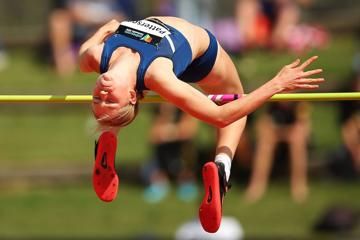Australian sprinter Jack Hale (© Getty Images)
When you were a child, did anyone ever warn you not to pull faces because, should the wind change, you would be stuck with that expression?
Something like that happened to Jack Hale, who is among an Australian team of 22 to compete at the IAAF World Youth Championships, Cali 2015 in Colombia this July. He will contest the 100m and 200m.
Hale, who turns 17 on 22 May, was already a fine sprinter/long jumper before 6 December last year when officials at the Australian All Schools Championships in Adelaide moved the finals of the 100m sprints from the front-straight, where the athletes had faced strong headwinds in the semis, to the wide-open back-straight, where they would be boosted by tailwinds.
The result was amazing: aided by a +3.4m/s tail wind which blew, judging from the bow flags that can be seen in race video, with remarkable consistency, Hale sped along the straight in 10.13 seconds.
The world youth best with legal wind is 10.19, while just three youth sprinters – all from the US – have run faster than 10.13 with the assistance of wind.
Behind Hale, Rohan Browning ran 10.18, Trae Williams 10.33 and Jordan Shelley and Jackson Miller-Gage recorded sub-10.50 performances. Shelley joins Hale in the team for Cali.
The wind changed – or, more precisely, the direction of the race relative to the wind – and now Hale is ‘stuck’ with the fastest all-conditions performance ever by a 16-year-old. Interestingly, the athlete who previously held that honour is Quincy Watts with a wind-assisted 10.17. Not a bad runner, Watts; he went on to become the 1992 Olympic 400m champion.
Hale’s public profile took off. Knowing it had a group of impressive young sprinters coming along, Athletics Australia had made a push to ensure some media coverage of the schools championships, but it was television and social media which took what was already being referred to as the Hale Storm and generated a maelstrom of publicity around it.
Not only did Hale’s name launch a thousand quips (mostly of the bad-pun variety), but his persona and demeanour helped drive things along even further. He is from Tasmania, the island state to the south of an island continent, a place not known for sprint talent. Small and baby-faced, he looks even younger than his tender years.
Additionally, up until his 10.13, Hale regarded himself as a long jumper. He told Fairfax Media’s Michael Gleeson he did not like to run. It made him so nervous he could not get on the track. His long jumping was coming along nicely – a best of 7.66m last October would have made him a prime candidate for that event at the World Youths.
Australian athletics was crying out for a good story. The Commonwealth Games campaign, almost as big as the Olympic Games and World Championships in Australian eyes, had been marked by the public bust-up between Sally Pearson and the head coach, Eric Hollingsworth. The sport’s performance was subject to both internal and external review.
A reluctant young sprinter, talented almost in spite of himself, hailing – you can’t help the puns – from an island state often overlooked by the rest of the nation. This was a story to run, and run.
As the Australian domestic tour got under way a few weeks later, in Hobart as luck would have it, 16-year-old Hale found himself the face of the meeting. This was not totally unprecedented, but you would probably have to go back to 1949 and 17-year-old Marjorie Jackson upstaging the great Fanny Blankers Koen over 100 yards to find another teen headlining an athletics meeting.
Hale won the 100m in open company in Hobart in 10.50, a cold, blustery wind registering 0.1m/s at the gauge. It was windy again (+2.8) when he won the under-18 race at the recent Australian Junior Championships in Sydney in 10.38, another occasion on which the 100m was turned around.
The wind cuts both ways, however. Hale’s home track in Hobart sits high above the Derwent River and is rarely calm. It is rarely favourable for sprints either, yet Hale has run 10.52, 10.50, 10.48, 10.44 and the Australian youth record of 10.42 there. All these performances would have resulted in a medal at all but one edition of the World Youth Championships.
1956 Olympic bronze medallist Hector Hogan, 1983 World Championships finalist Paul Narracott, national record-holder Patrick Johnson and Matt Shirvington are the royalty of Australian men’s 100m over the years.
Shirvington knows all about exciting expectations. After he ran 10.07 at the 1998 World Cup in Johannesburg and 10.03 at the Commonwealth Games a few days later, Shirvington was looked at as the first Australian sub-10 runner. It never happened, but he reached semi-finals at three consecutive global championships from 1999 to 2001.
Now a presenter for Fox Sports, Shirvington assessed Hale after the Australian Junior Championships.
“He has such a good future ahead of him,” said Shirvington. “Physically, he has so much more to improve – which is really good for him.”
Hale and his 21 teammates in Cali could be joined by up to four combined eventers after the national titles in those events are conducted at the Australian Championships in Brisbane this weekend.
The minimum requirement for selection was that all athletes had achieved at least two qualifying performances equivalent to a top-eight result at recent editions of the World Youth Championships.
Besides Hale, among the brighter medal prospects are long jumper Darcy Roper, who recently upped his best to 7.68m, hammer thrower Ned Weatherly (79.03m), high jumper Josh Connolly (2.14m) and Samantha Peace in the women’s discus (47.93m).
In Donetsk two years ago, Australia took four medals – three gold and one bronze – to finish fourth on the medals table behind Jamaica, Kenya and Ethiopia.
Len Johnson for the IAAF






